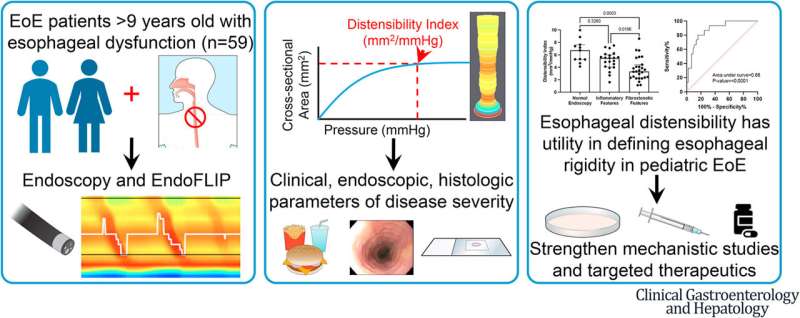A new way to improve outcomes in kids with eosinophilic esophagitis

A new study from Ann & Robert H. Lurie Children's Hospital of Chicago determined the threshold for a new measure of early scarring in the esophagus of children with eosinophilic esophagitis (EoE), which allows immediate intervention during endoscopy to halt further damage and prevent food from getting stuck in the esophagus (feeding tube) of kids with this condition. The findings were published in the journal Clinical Gastroenterology and Hepatology.
EoE is a chronic immune-mediated disorder of the esophagus that affects adults and children with a prevalence of 0.5 to 1 per 1000. Left untreated, chronic inflammation promotes scarring of the esophagus, and the development of esophageal rings and stricture, which interferes with passage of solid food and can cause impaction (when food is stuck in the esophagus and cannot dislodge).
Endoscopic Functional Luminal Impedance Probe (EndoFLIP) was used in the study to measure the "distensibility index," which is a functional measure of how much force is required to stretch open the esophagus. Previously, the extent of scar tissue in the esophagus could only be evaluated visually during endoscopy, making it challenging to detect the early changes and intervene before the damage becomes more extensive.
"This is a gamechanger in how we care for kids with EoE," said senior author Joshua Wechsler, MD, MSCI, Medical Director of Eosinophilic Gastrointestinal Diseases Program at Lurie Children's, CURED Research Scholar at Lurie Children's, and Assistant Professor of Pediatrics at Northwestern University Feinberg School of Medicine.
"Now, if distensibility is low, we can dilate the esophagus during the same procedure, and because we can pinpoint exactly where the scarring is, our intervention is more targeted and takes much less time. We are seeing improvements in symptoms, which is incredibly exciting."
More information: Natalie V. Hoffmann et al, Esophageal Distensibility Defines Fibrostenotic Severity in Pediatric Eosinophilic Esophagitis, Clinical Gastroenterology and Hepatology (2022). DOI: 10.1016/j.cgh.2022.08.044

















